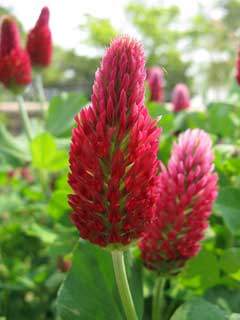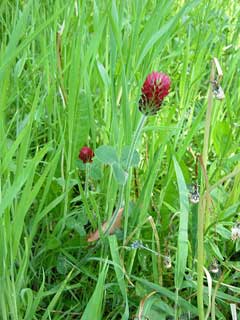 |
|
commons.wikimedia.org/wiki/User:KENPEI |
 |
| commons.wikimedia.org/wiki/User:Murderbike |
Translate this page:
Summary
Physical Characteristics

 Trifolium incarnatum is a ANNUAL growing to 0.5 m (1ft 8in) at a medium rate.
Trifolium incarnatum is a ANNUAL growing to 0.5 m (1ft 8in) at a medium rate.
See above for USDA hardiness. It is hardy to UK zone 4 and is not frost tender. It is in flower from May to September, and the seeds ripen from July to October. The species is hermaphrodite (has both male and female organs) and is pollinated by Bees. The plant is self-fertile.
It can fix Nitrogen.
Suitable for: light (sandy), medium (loamy) and heavy (clay) soils, prefers well-drained soil and can grow in nutritionally poor soil. Suitable pH: mildly acid, neutral and basic (mildly alkaline) soils. It cannot grow in the shade. It prefers moist soil. The plant can tolerates strong winds but not maritime exposure.
UK Hardiness Map
US Hardiness Map
Synonyms
Trifolium incarnatum L. var. elatius
Plant Habitats
Meadow; Cultivated Beds;
Edible Uses
Edible Parts: Seed
Edible Uses: Tea
The seeds can be sprouted and eaten in salads[183]. They can also be dried and ground into a nutritious flour[183]. Dried flower heads are a tea substitute[183].
References More on Edible Uses
Medicinal Uses
Plants For A Future can not take any responsibility for any adverse effects from the use of plants. Always seek advice from a professional before using a plant medicinally.
None known
References More on Medicinal Uses
The Bookshop: Edible Plant Books
Our Latest books on Perennial Plants For Food Forests and Permaculture Gardens in paperback or digital formats.

Edible Tropical Plants
Food Forest Plants for Hotter Conditions: 250+ Plants For Tropical Food Forests & Permaculture Gardens.
More

Edible Temperate Plants
Plants for Your Food Forest: 500 Plants for Temperate Food Forests & Permaculture Gardens.
More

More Books
PFAF have eight books available in paperback and digital formats. Browse the shop for more information.
Shop Now
Other Uses
References More on Other Uses
Cultivation details
Succeeds in a moist, well-drained circum-neutral soil in full sun[200]. Succeeds in poor soils. The ssp. molinerli is the form of this species that is native to Britain, whilst ssp. incarnatum is naturalized in S. Britain and is the form grown as a green manure crop[17]. It grows well in an apple orchard, the trees will produce tastier fruit that stores better[201]. It should not be grown with camellias or gooseberries because it harbours a mite that can cause fruit drop in the gooseberries and premature budding in the camellias[201]. Fairly resistant to 'clover rot'[87]. This species has a symbiotic relationship with certain soil bacteria, these bacteria form nodules on the roots and fix atmospheric nitrogen. Some of this nitrogen is utilized by the growing plant but some can also be used by other plants growing nearby[200]. Buttercups growing nearby depress the growth of the nitrogen bacteria by means of a root exudate[201]. When removing plant remains at the end of the growing season, it is best to only remove the aerial parts of the plant, leaving the roots in the ground to decay and release their nitrogen.
References Carbon Farming Information and Carbon Sequestration Information
Temperature Converter
Type a value in the Celsius field to convert the value to Fahrenheit:
Fahrenheit:
The PFAF Bookshop
Plants For A Future have a number of books available in paperback and digital form. Book titles include Edible Plants, Edible Perennials, Edible Trees,Edible Shrubs, Woodland Gardening, and Temperate Food Forest Plants. Our new book is Food Forest Plants For Hotter Conditions (Tropical and Sub-Tropical).
Shop Now
Plant Propagation
Pre-soak the seed for 12 hours in warm water and then sow in spring to early summer in situ. The seed can also be sown in early autumn as a winter green manure.
Other Names
If available other names are mentioned here
Native Plant Search
Search over 900 plants ideal for food forests and permaculture gardens. Filter to search native plants to your area. The plants selected are the plants in our book 'Plants For Your Food Forest: 500 Plants for Temperate Food Forests and Permaculture Gardens, as well as plants chosen for our forthcoming related books for Tropical/Hot Wet Climates and Mediterranean/Hot Dry Climates. Native Plant Search
Found In
Countries where the plant has been found are listed here if the information is available
Weed Potential
Right plant wrong place. We are currently updating this section.
Please note that a plant may be invasive in one area but may not in your area so it’s worth checking.
Conservation Status
IUCN Red List of Threatened Plants Status :

| Related Plants
|
| Latin Name | Common Name | Habit | Height | Hardiness | Growth | Soil | Shade | Moisture | Edible | Medicinal | Other |
| Trifolium bifidum | Piñole Clover, Notchleaf clover | Annual | 0.5 |
0-0
| | LMH | N | M | 2 | 0 | 3 |
| Trifolium ciliatum | Foothill Clover | Annual | 0.5 |
0-0
| | LMH | N | M | 2 | 0 | 3 |
| Trifolium cyathiferum | Cup Clover | Annual | 0.5 |
0-0
| | LMH | N | M | 1 | 0 | 2 |
| Trifolium dichotomum | Branched Indian Clover | Annual | 0.6 |
0-0
| | LMH | N | M | 2 | 0 | 2 |
| Trifolium dubium | Suckling Clover | Annual | 0.5 |
0-0
| | LMH | N | M | 0 | 1 | 3 |
| Trifolium fimbriatum | Springbank Clover, Cows clover | Perennial | 1.0 |
0-0
| | LMH | N | M | 3 | 0 | 2 |
| Trifolium fucatum | Sour Clover, Bull clover | Annual | 0.6 |
0-0
| | LMH | N | M | 2 | 0 | 2 |
| Trifolium fucatum virescens | | Annual | 0.6 |
0-0
| | LMH | N | M | 2 | 0 | 2 |
| Trifolium gracilentum | Pin-Point Clover, Palmer's clover | Annual | 0.6 |
0-0
| | LMH | N | M | 2 | 0 | 2 |
| Trifolium hybridum | Alsike Clover | Perennial | 0.6 |
0-0
| | LMH | N | M | 2 | 1 | 2 |
| Trifolium lupinaster | Lupine clover | Perennial | 0.5 |
0-0
| | LMH | N | M | 1 | 0 | 2 |
| Trifolium macrocephalum | Bighead Clover, Largehead clover | Perennial | 0.3 |
4-8
| | LMH | N | M | 1 | 0 | 3 |
| Trifolium microcephalum | Smallhead Clover | Annual | 0.6 |
-
| | LMH | N | M | 1 | 0 | |
| Trifolium obtusiflorum | Clammy Clover | Annual | 1.0 |
0-0
| | LMH | N | M | 2 | 0 | 2 |
| Trifolium ornithopodioides | Birdsfoot Fenugreek, Bird clover | Annual/Perennial | 0.2 |
0-0
| | LMH | N | MWe | 1 | 0 | 3 |
| Trifolium pratense | Red Clover | Perennial | 0.6 |
5-9
| M | LMH | N | M | 3 | 3 | 4 |
| Trifolium repens | White Clover, Dutch Clover, Purple Dutch Clover, Shamrock, White Clover | Perennial | 0.1 |
4-8
| M | LMH | N | M | 3 | 2 | 4 |
| Trifolium subterraneum | Subterranean Clover | Annual | 0.2 |
7-10
| | LMH | N | M | 1 | 0 | 4 |
| Trifolium tridentatum | Tomcat Clover | Annual | 0.6 |
0-0
| | LMH | N | M | 2 | 0 | 2 |
| Trifolium variegatum | Whitetip Clover | Annual | 1.0 |
-
| | LMH | N | M | 1 | 0 | |
|
Growth: S = slow M = medium F = fast. Soil: L = light (sandy) M = medium H = heavy (clay). pH: A = acid N = neutral B = basic (alkaline). Shade: F = full shade S = semi-shade N = no shade. Moisture: D = dry M = Moist We = wet Wa = water.

Expert comment
Author
L.
Botanical References
17
Links / References
For a list of references used on this page please go here
Readers comment
| Add a comment |
|
If you have important information about this plant that may help other users please add a comment or link below. Only comments or links that are felt to be directly relevant to a plant will be included. If you think a comment/link or information contained on this page is inaccurate or misleading we would welcome your feedback at [email protected]. If you have questions about a plant please use the Forum on this website as we do not have the resources to answer questions ourselves.
* Please note: the comments by website users are not necessarily those held by PFAF and may give misleading or inaccurate information.
To leave a comment please Register or login here All comments need to be approved so will not appear immediately.
|
Subject : Trifolium incarnatum
|
|
|
|